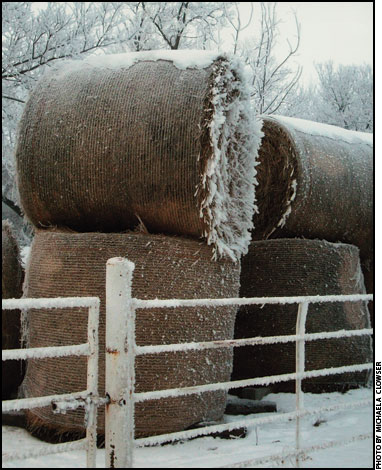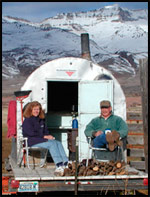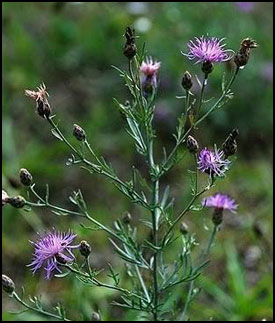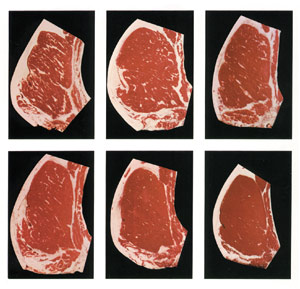MANAGEMENT...
 Time to Inventory, Purchase Hay
Time to Inventory, Purchase Hay
Due to dry conditions, the majority of Kentucky livestock producers are already into their winter feeding programs, which some began as early as September. Producers need to inventory their hay supplies now to ensure they have enough to last through the winter. If they find they're short, buying additional hay now can save them a lot of headaches later, said Tom Keene, hay marketing specialist with the University of Kentucky (UK) College of Agriculture.
The good news is Kentucky forage producers had prime haymaking weather earlier this year and were able to get good yields due to adequate springtime moisture. Read more.

Ron Torell with his wife, Jackie
Cow Camp Chatter
Budgeting for stewardship
It is often said that there are no better stewards of the land than agriculturists. With stewardship comes the responsibility of managing your property in the interest of long-term sustainability. At the end of your ranching career, when you turn your operation over to the next generation, will your ranch and land be in better shape than when you took over management and/or ownership? Have you always had good stewardship of the land in mind when it comes to the management of your ranch? Do you treat and manage the land, your neighbors and employees, both two- and
four-legged, with integrity, respect and dignity? In this edition of “Cow Camp Chatter,“ let's talk about how we might budget for the infrastructure maintenance of our ranches in order to become better long-term stewards of the land. Read more.
 Aggressive Weed a Potential Problem for Livestock Producers
Aggressive Weed a Potential Problem for Livestock Producers
An aggressive perennial weed, common throughout the western United States, has found its way to Ohio, overtaking pastures and hay fields and creating an undesirable feeding situation for livestock.
Clif Little, an Ohio State University Extension educator, said that dense infestations of spotted knapweed have been found in Guernsey County and pockets of the weed are extending into Muskingum, Morgan, Noble, Belmont and Monroe counties in pastureland and along roadways. Read more.
Efficient, High-Quality beef
Researchers in muscle biology uncover new interactions between implants and marbling.
 Producers have been using implants to improve cattle efficiency for decades, even before the use of value-based grids. But now that quality grade has become an important factor in marketing beef and maintaining demand, many scientists are taking a closer look at the relationship between marbling and implants.
Producers have been using implants to improve cattle efficiency for decades, even before the use of value-based grids. But now that quality grade has become an important factor in marketing beef and maintaining demand, many scientists are taking a closer look at the relationship between marbling and implants.
Brad Johnson, Texas Tech University, is one of those people. He recently co-authored a white paper, "Factors affecting intramuscular adipose tissue development in beef cattle." It documents how marbling is formed, down to the genes that influence it and how implants fit into that process. Read more.
Prescribed Burns May Need to Include
Both Summer and Winter Fires
AgriLife Research determines best combination for grass regrowth.
To the untrained eye, grass is grass. But for the nutrition and palates of wildlife and cattle, the grass is as different as roast beef and green beans or potato chips and dip are to humans, according to a Texas AgriLife Research scientist. Sometimes it takes fire to set the best plate, or pasture, for the animals utilizing the grass, said Jim Ansley, AgriLife Research range ecologist. Landowners must know whether to "barbecue" or "bake," or use a combination to manage the grasses.
Because of mesquite invasion and overgrazing, most grasslands once dominated by warm-season midgrasses have degraded to cool-season midgrasses (mainly Texas wintergrass) and warm-season shortgrasses (mainly buffalograss), Ansley said. Historical fire regimes likely included a mixture of summer and winter season fires, and this may have been important for the maintenance of the perennial midgrasses in these ecosystems. Read more.

Kris Ringwall
Beef Talk
Why is my grandfather a steer?
November seems to come quickly, and soon to follow will be Christmas. The common saying, "how time flies," is certainly true. Likewise, college campuses are in their prime, with classes churning vigorously and trying to instill knowledge.
The process is not as simple as vaccinating calves, but one hopes a good response is achieved. Healthier calves and wiser students are good goals to achieve and, when met, good for everyone. The response will dictate the future and lay the course for years to come.
The genetics class that I teach is no different. Watching minds churn is exciting, if not a bit scary. If one thinks one can rest on his or her laurels and simply accept what is present, one is greatly mistaken. The world of genetics will cause some deep pondering, even if one has a tendency to resist much thoughtful exercising of the mind. Read more.
New Products
Industry affiliates provide a wide array of products and services to assist you on the farm and ranch. Here's an assortment of new products to hit the market recently.
• New labels, packaging, for additions to company products
• Enhanced respiratory protection
• Stock trailer now offered as bumper pull>
• Web news
• New website for coccidiosis information
• Patent-pending microbial stabilization media and delivery
Yellow Wheat?
Yellow wheat in fall may have several causes.
Dry weather and other factors can cause wheat to be yellowish or pale in the fall, instead of a nice, healthy green. When that happens, producers want to know why, said Jim Shroyer, Kansas State University (K-State) Research and Extension crop production specialist.
Shroyer said the common reasons for yellow wheat in fall are:
• Poor root growth. This may be due to dry soils or poor seedbed conditions at planting time. If the plants have been emerged for several weeks or more and if they can be pulled up easily and have only a couple primary roots visible, then the plants' root systems are not extensive enough to provide enough nutrients.
• Nitrogen deficiency. Nitrogen deficiency causes an overall yellowing of the plant, with the lower leaves dying from the tips inward. Nitrogen deficiency in the fall also results in reduced tillering, top growth and root growth. The primary causes of this kind of nitrogen deficiency are insufficient fertilizer rates, leaching from heavy rains, and the presence of heavy amounts of crop residue that immobilize nitrogen.
• Leaf rust or tan spot. If leaf rust infects young seedlings in the fall, the plants may turn yellowish; fall infections of leaf rust are not common in Kansas but can occur. Tan spot also can cause wheat to turn yellow in the fall. Treating fields in the fall for leaf rust or tan spot rarely if ever pays, even if those diseases do cause yellowing, because cold temperatures in the winter normally cure the problem.
• Low temperatures. When temperatures are quite cold at the time wheat emerges, the result can be yellow banding on the leaves. If so, the symptoms should eventually fade away.
Angus Advisor
Click here for November herd management tips from cattle experts across the nation. Advice separated by region.
[Click here to go to the top of the page.]




